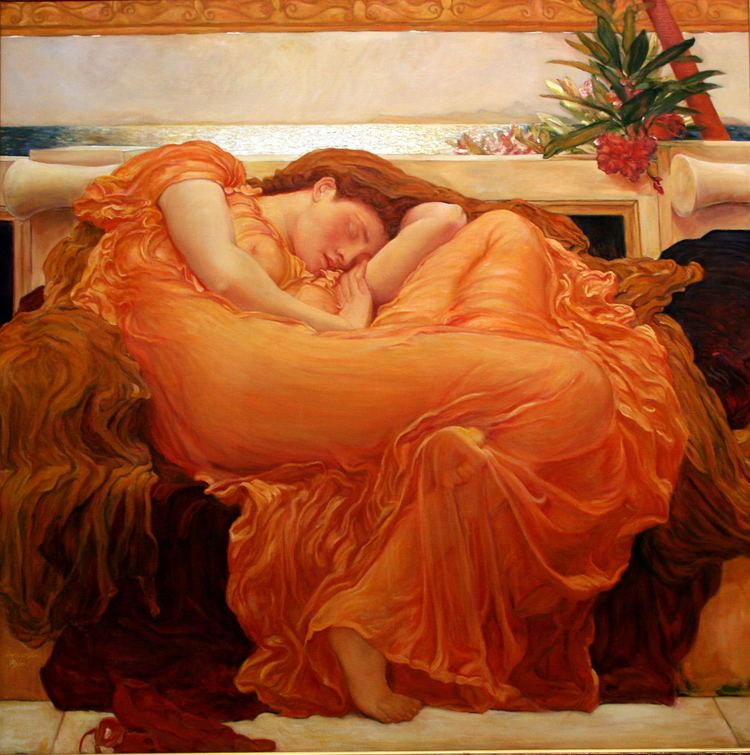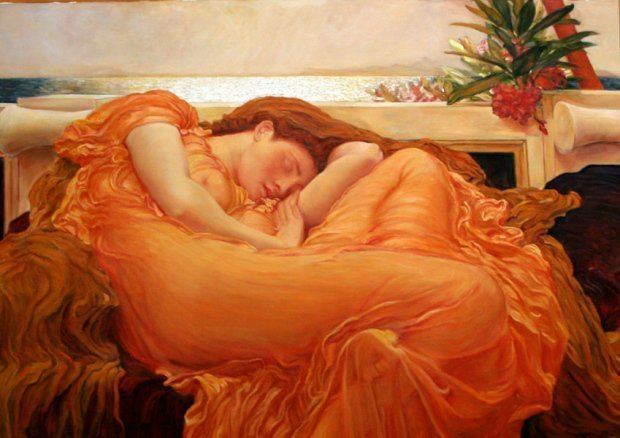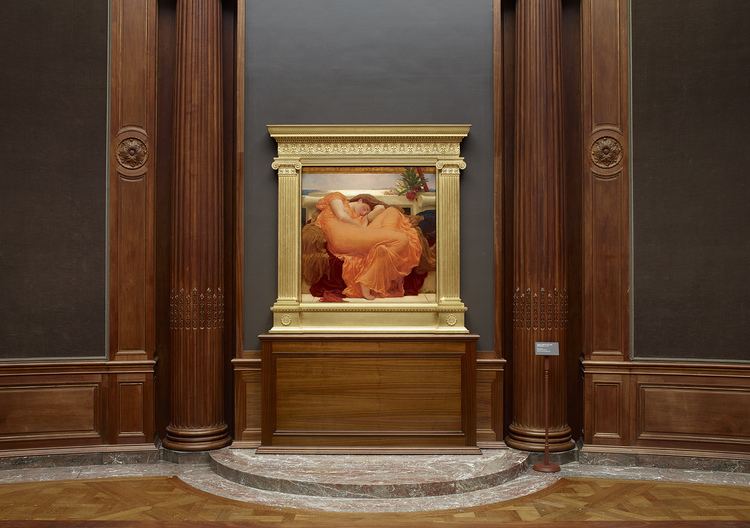Dimensions 1.2 m x 1.2 m Period Academic art Media Oil paint | Created 1895 | |
 | ||
Similar Frederic Leighton artwork, Oil paintings | ||
Leighton s flaming june
Flaming June is a painting by Sir Frederic Leighton, produced in 1895. Painted with oil paints on a 47-by-47-inch (1,200 mm × 1,200 mm) square canvas, it is widely considered to be Leighton's magnum opus, showing his classicist nature. It is thought that the woman portrayed alludes to the figures of sleeping nymphs and naiads the Greeks often sculpted.
Contents
- Leighton s flaming june
- Art reproduction leighton flaming june hand painted step by step
- Appraisal
- Provenance
- Models
- References

Flaming June disappeared from view in the early 1900s and was only rediscovered in the 1960s. It was auctioned shortly after, during a period of time known to be difficult for selling Victorian era paintings, where it failed to sell for its low reserve price of US$140 (the equivalent of $1,126 in modern prices). After the auction, it was promptly purchased by the Museo de Arte de Ponce in Ponce, Puerto Rico, where it currently resides.

Art reproduction leighton flaming june hand painted step by step
Appraisal
Flaming June was first begun as a motif to adorn a marble bath in one of Leighton's other works, Summer Slumber. He became so attached to the design that he decided to create it as a painting in its own right.

According to art historian Andrew Graham-Dixon "her pose is loosely modelled on that of Michelangelo's famous statue of Night, in the Medici Tombs in Florence, which Leighton regarded as one of the supreme achievements of Western art." The position of the sleeping woman gave Leighton a great deal of trouble. He made several preliminary sketches to determine the way in which she should lie; in particular he had difficulty making the angle of her right arm look natural. His studies show that the picture went through at least four evolutionary sketches before Leighton came to the end result. Out of these studies, four are nude and one is draped. The draped figure looks the least lifelike, demonstrating Leighton's need to draw from a naked model to achieve a fidelity to nature.
The toxic oleander branch in the top right possibly symbolizes the fragile link between sleep and death.

Flaming June has become Leighton's most recognisable picture. Samuel Courtauld, founder of the Courtauld Institute, called it “the most wonderful painting in existence”. The realism of the transparent material worn by the sleeping woman, the stunningly rich colours and the perfectly recreated marble surround are characteristic of Leighton's work, as is his use of natural light. He allows the sunset in the background to appear as molten gold.
Provenance
The painting's first owners, The Graphic magazine, bought it to create a high-quality reproduction which was given away as a Christmas gift in 1895. When Leighton died in January 1896 it was put in their office window which was passed by the funeral procession. It was loaned to the Ashmolean Museum in early 1900s, its whereabouts after this are unknown; it was rediscovered in a Battersea home in the early 1960s, boxed in over a chimney. Andrew Lloyd Webber saw it soon afterwards in a shop on the Kings Road, but his grandmother refused to lend him the £50 asking price, stating: "I will not have Victorian junk in my flat".
In 1963 Luis A. Ferré – the noted Puerto Rican industrialist and politician, who would be elected governor five years later – was on a trip around Europe, engaged in purchasing paintings and sculptures for the Museo de Arte de Ponce in Puerto Rico, which he had founded. Passing by The Maas Gallery, London in 1963, Ferré was enthralled by the work, and offered to pay £2,000 for the painting. Antonio Luis Ferré, the industrialist's son, many years later related that his father spent a sleepless night worried that, in the final stages of the transaction, Jeremy Maas, then owner of The Maas Gallery and Flaming June, would retract his offer and sell it to another buyer. Ferré prevailed, and Flaming June was taken to the Museo de Arte de Ponce and prominently displayed. With the renewed interest in Victorian art, it was also loaned to important exhibitions around the world. Flaming June was on display at the Museo del Prado in Madrid in 2008, the Staatsgalerie Stuttgart in Germany in 2009 and in the Frick Collection in 2015.
In 2015 an original pencil and chalk study for the painting – the model's head – was found on the back of a bedroom door in the mansion inherited by Bamber Gascoigne after the death of his great aunt Mary Innes-Ker, Duchess of Roxburghe.
In 2016 the painting was loaned to the Leighton House Museum in Kensington, and was displayed in the studio where it was created.
Models
While the body of the woman remains a mystery, there is speculation that the face is that of either Dorothy Dene or Marie Lloyd.
